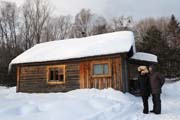Tigers are the largest members of the cat family (Felidae) and the
Siberian tigers are the largest of the tiger subspecies. The Siberian
tigers once ranged throughout the Korean Peninsula, north China, Russian Far
East, and eastern Mongolia. Today, this population inhabits mainly
the Sikhote Alin mountain region in Khabarovsk and Primorye Krais in the
Russian Far East. An initial census held in 2015 indicated that the
Siberian tiger population was about 480–540 individuals in the Russian Far
East, including 100 cubs, and may be only about 20-30 in China along the
Russian border. The Siberian tiger was also called "Amur tiger",
"Manchurian tiger", "Ussurian tiger", or 東北虎.
Although traditionally
considered part of Siberia, the Russian Far East is categorized separately
from Siberia in Russian regional schemes. Khabarovsk and Primorye
Krais are influenced by cold, dry continental air in the winter.
Temperatures at this time of year are well below freezing even on the coast.
Our main destination, Durminskoye forest reserve, is the only reserve in the
large Khabarovsk krai that combines two factors: 1) preserving flora and
fauna of the unique Ussuri taiga and 2) supervising restricted hunting for
selected ungulates (hoofed animals) as per local legislation. The
reserve’s recent progression into eco-tourism not only allows visitors to
enjoy this beautiful taiga forest and its wildlife, but also helps sustain
some of the local community with employment on the reserve.
Getting there ...
| We had a late night flight on
1/31 from SFO (US) via ICN (Korea) and NRT (Japan), and finally
arrived at KHV (Russia) in the evening on 2/2 with more than 24
hours of traveling time. Due to the outbreak of coronavirus,
most people wore masks on the airplane even for
flight attendants.
On the route from ICN to NRT, there were only a few passengers in
our cabin section in the huge A380 airplane. When we got to
NRT, we were the only passengers going through the transfer from
Terminal 1 to Terminal 2. We booked this wildlife tour
from Royle Safaris.
It was a customized private tour with two parts: 1) this
Siberian tiger tracking and 2)
Japan (Hokkaido and Nagano) wildlife. |
2/3 (Day 2) ...
- Khabarovsk
We stayed a night in Khabarovsk.
We walked to an lookout point in the early morning for a glance of the
frozen Amur River. We met our Russian interpreter Dasha in the
hotel lobby as she will accompany us to Durminskoye Reserve for the next 6
days.
- Driving to Durminskoye (9AM to 1:30PM)
Durminskoye Reserve cannot be found on Google Map. According to
its GPS location, it's located about ~20 miles south of Durmin, the
closest town shown on Google Map. Although the total
distance from Khabarovsk may be only a little over 100 miles, it took us
more than 4 hours to get to the camp (with a grocery shopping detour).
When we entered the forest unpaved road, the clean white snow started to
reveal all sorts of wild animal tracks. The excitement of our
first look of fresh tiger
footprints was beyond any word. We also saw a
half-eaten dead dog carcass
which was another clear evidence of tigers' presence.
- Durminskoye Reserve
Durminskoye forest reserve is the only
reserve in the large Khabarovsk krai that combines two factors: 1)
preserving flora and fauna of the unique Ussuri taiga and 2) supervising
restricted hunting for selected ungulates (hoofed animals) as per local
legislation. The reserve was established by
Alexander Batalov in 1993 to preserve and adhere to rational use of
area's natural resources, and engage in the photography and video
observation of its resident wildlife, most notably the highly endangered
Amur tiger (Siberian tiger). It was featured in Gordon
Buchanan's (wildlife filmmaker) "Amba
the Russian Tiger" (2008).
Alexander is not only educated in
Wildlife Conservation (he graduated from the Wildlife Faculty of the
Irkutsk State Academy of Agriculture in Irkutsk, Siberia), but has over
40 years in experience with wildlife management of game reserves.
During his career he has trained over 600 students in forestry
specialism and has also published around 40 scientific studies on
wildlife ecology. He is an expert on methods for monitoring and tracking
wildlife populations; skills put to good use in the Durminskoye reserve.
- Camera trap
These were some image sequences captured one of
the camera traps during our stay.
2/4 (Day 3) ...
- We started to follow the routines of the daily life here:
breakfast at 9AM, morning patrol at 10:30AM, coming back to the camp for
lunch at ~1:30PM-2:00PM, afternoon snowmobile at 4:00PM -- 5:30PM,
Russian sauna (banya, the best relaxation after a cold day) at 5:30PM,
and dinner at 7PM.
 |
 |
|
|
- Morning patrol
On the day before our arrival, Sergei found a
reindeer carcass (Sergei is Alexander’s student. He is teaching in
university, but still comes here often to do research and continues to
learn from Alexander). Based on the tiger’s feces, he knew its meal was
a reindeer, and by the circling of crows, he found this corpse not far
from the road. Alexander thinks this 100kg reindeer was probably eating
or sleeping when the 140kg tigress attacked. Tigers usually hunt small
animals like wild boars, they rarely prey big mammals like this. We were
very lucky to find this rare sight. Two BBC film crews arrived the camp
one day earlier. They were here to film for "Frozen Planet 2". Sergei
helped these two young people to set up trap cameras, hoping the tiger
will return to continue eating the not-finished reindeer meat.
- Afternoon
We went out on a sled towed by snowmobile. It's a
fun way to move around by lying down on the sled as we could see trees
passing by above us while we were bouncing up and down on the snowmobile
tracks. After setting up a few more camera traps, Alexander let
Woanyu drive the snowmobile back to the camp (I don't know how he knew
Woanyu is a better driver than I am...)
- Camera trap
One of the camera traps Woanyu set up caught a
tigress walking by after ~ 3.5 hours after we left the spot. You
can check out the timestamps on the images below.
2/5 (Day 4) ...
- Morning
It's a very cold day at -32C (or -26F) in the morning (I
got a picture of -30C from the
thermometer outside our window). A bottle of beer on the floor
of the mud room in our cabin exploded at this extreme temperature...
Although it was cold, it was a beautiful day in the white snow covered
forest.
- Afternoon
We went out again in the sled-snowmobile in the
afternoon. It was so cold that Woanyu and I thought our toes may
be already frozen...
2/6 (Day 5) ...
- Morning
We went out with Alexander again and we
were really impressed by his persistence and patience for devoting his
time and energy in tracking and protecting tigers. He got off cars
often to investigate and measure footprints and tracks, and walked into
the woods alone to see where those tracks led to. Every new
footprint was like a new discovery for him even he has done this for more
than 30 years
- We stayed in our cabin after lunch in the afternoon because we
planned to go on a "night safari" at 6PM. Although we did not
really see anything on this one-hour drive, it's quite a spooky feeling
to drive in the forest at night without turning on the headlights.
2/7 (Day 6) ...
- Morning
It was a snowy day like my perfect dream: sitting by the
window in a cozy/warm cabin looking at the snow flakes flying down from
the sky (well, we could not make hot tea in our cabin, otherwise it was
really perfect for me). We watched how Alexander climbed a
tree to find a good angle to set up a camera trap (I don't think I could
climb trees like him...). We chat more about our lives and
Russia/US/Taiwan/China cultures and politics in the car. It was
interesting to know Russian people like Trump, and we were the first
Taiwanese visiting this forest reserve.
- Afternoon
Two of the camp staff took us on another snowmobile
ride to an old cabin to have a remote picnic. They made fire to
warm up the cabin, and made hot tea and grilled sausages and onions.
It was simple but luxurious experience in a total rural environment.
2/8 (Day 7) ...
-
Leaving the camp
It's hard to believe it was our last day here and we
were about to leave the camp after breakfast (we had an early breakfast
at 7:30AM). We saw a fresh tiger mark with the full body and tail
lying on the ground on our way out of the camp.
- Utyos Wildlife Rehabilitation Center
There was a captive male tiger which was badly injured in its cheek that
it won't be able survive in the wild. Although it was disfigured,
it was still a mighty majestic animal that we were awed by its presence.
We finally saw a tiger :-)
- Khabarovsk
We were back to Khabarovsk at about 3:30PM and concluded our wilderness
adventure.
After a short break at the hotel, we walked around to
explore the city on foot. Khabarovsk was the
administrative center of the Far Eastern Federal District of Russia from
2002 until December 2018 (Vladivostok took over that role). It is the
largest city in the Russian Far East with a population of more than half
a million people. The Russian explorers and raiders set up a
number of fortified camps on the Amur in 1650s. It is usually
thought that the first such camp was the fortified winter camp
named Achansk (Ачанск), built by the Cossacks of Yerofey Khabarov in
September 1651. After the Treaty of Nerchinsk (尼布楚條約)
in 1689, the area became a part of the Qing Empire for the next century
and a half. In 1858, the area was ceded to Russia under the Treaty
of Aigun (璦琿條約). The Russians founded the military outpost
of Khabarovka (Хаба́ровка), named after Yerofey Khabarov. The post later
became an important industrial center for the region. In 1893, it was
given its present name Khabarovsk (Хаба́ровск).
2/9 (Day 8) Going Next ...
We had an early morning flight from Khabarovsk via
Vladivostok to our next destination Narita, Tokyo for our second part of
tour: Japan (Hokkaido and Nagano)
wildlife. When we were ready to take off, I was excited to see
some rare Russian airplanes (An-30
and Mi-8) although I was supposed to
see wildlife, not airplanes, for this trip :-)
[Siberia
Gallery]
[Back to Photo Page]